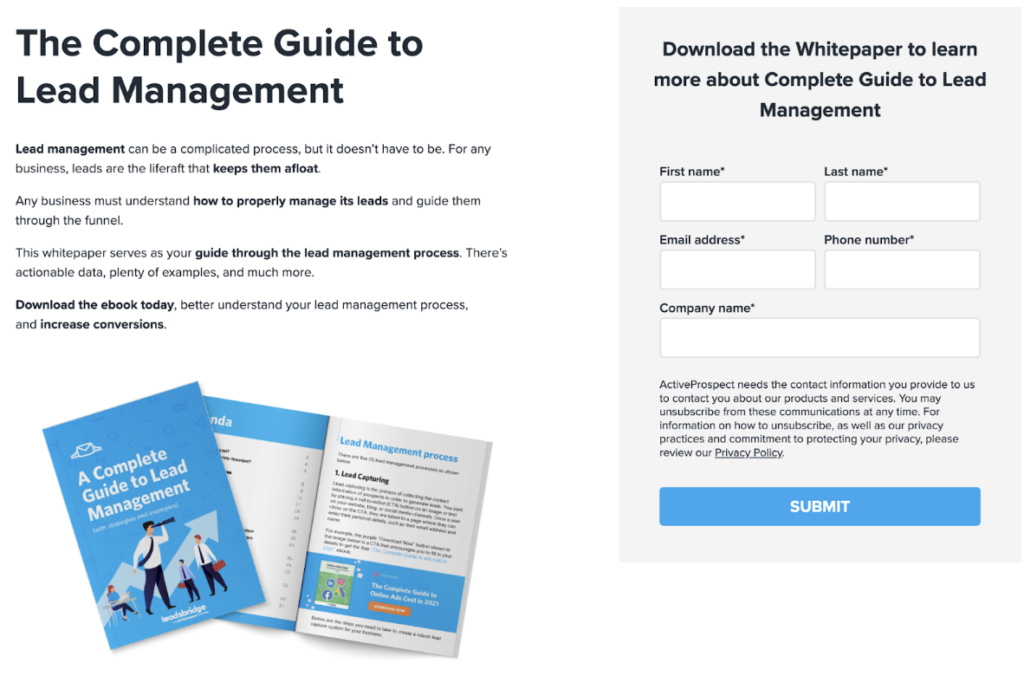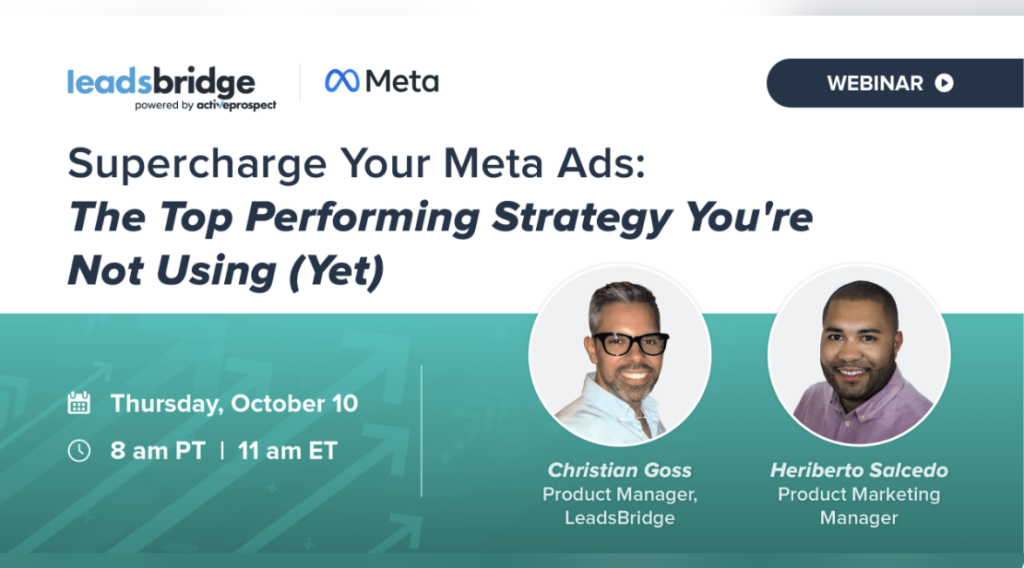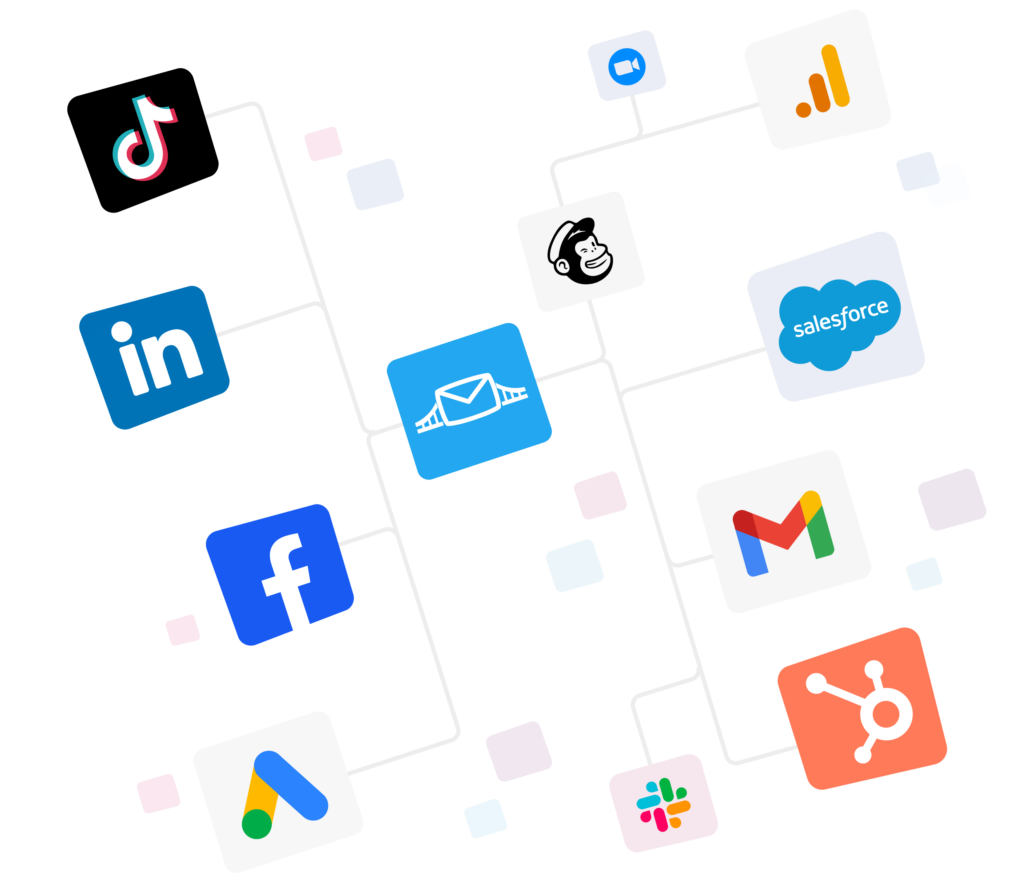
Leads are the lifeblood of every business, and the generation of these integral players is typically the primary focus when deciding which tactics to bring into action. Of course, these decisions require deliberation based on insights, behaviors and trends.
- What is lead management?
- Why is lead management important?
- Step-by-step guide to lead management process
- Choosing your lead management software
- Top lead management strategies
- What is lead management automation & why It matters
- Final thoughts
- What is lead management?
- Why is lead management important?
- Step-by-step guide to lead management process
- Choosing your lead management software
- Top lead management strategies
- Final thoughts
However, prompting a lead to entering your sales funnels is not always conducive with a conversion. So, how does one bridge the gap between generation and conversion? The solution is having a solid lead management.
This article gives you an understanding of the nature of lead management and the processes and strategies that accompany it. We’ll also explore five of the best lead management software that your business can implement to increase acquisition.
This includes tools that can make that happen via automation, such as:
What is lead management?
Lead management is the process that is used by businesses to connect with prospects and convert them into paying customers. This can be done through a variety of targeted strategies and tools specifically designed for the management of leads.
As a rule of thumb, a business’s success increases along with lead volume. However, this brings the challenge of maintaining control. For instance, approximately 79% of leads never convert.
General issues include lead leakage, lack of consistency and inefficient follow-up systems. That’s why implementing lead management practices is a must.
A robust lead handling system offers businesses the opportunity to successfully capture, nurture, qualify and distribute leads to respective departments. This allows you to adequately prime users for conversions. Without the right tools, however, this is virtually impossible.
Why is lead management important?
Generating leads is resource-heavy. It requires running campaigns on multiple channels which means orchestrating multi-faceted, informed strategies. An effective management plan is necessary to make sure those efforts are not wasted and opportunities are maximized.
Now, let’s take a closer look at the five key benefits of lead management below.
1. Focusing on leads with high quality
Lead qualification is a fundamental step within the lead management process. It helps you identify qualified leads and segment them based on the attributions that are considered favorable.
Sieving through leads lets you concentrate on high-value leads and maximize sales opportunities. Advertising platforms also incentify these efforts by making your ads cheaper down the line.
2. Getting the most out of your ad spend
Knowing which platforms offer the best generation opportunity for your business is important. This means no more losing money on platforms that have little to no return and wasting time on redundant activities.
This knowledge allows you to switch your attention to specific channels, build campaigns that are best suited to these platforms and fund them accordingly.
If budgeting is something you are just noticing, you can learn everything you need to know about online ad costs here.
3. Offering better experience to your potential leads
The data generated from lead management can be leveraged for offering better offers and even more effective UX. For instance, offering educational material that is highly in demand by your potential leads.
This can be used to prompt them towards an informed purchasing decision, particularly with prospects who are still on the fence. You can use lookalike audiences to target people who are similar to your previous buyers.
This again, requires you to build continuous data transfer bridges between your CRM to, say, Meta or LinkedIn.
Learn more about LinkedIn Matched Audiences, and Meta’s custom audiences if this is something you are considering.
4. Increase marketing and sales productivity
Having a knowledge of your lead quality allows you to prioritize them. This means focusing your communications on the most suitable leads, which are then passed to the sales team at the most opportune time.
This series of events increases the likelihood of achieving conversions and enhances overall sales productivity. Meta, for instance, offers tools like Conversion leads optimization, which is a performance goal that channels your campaigns toward higher quality leads.
Step-by-step guide to lead management process
Having established the value lead management provides, you may now be asking, how does lead management work?
It consists of five main processes that your business is recommended to follow. Here’s a step-by-step overview.
1. Lead capturing
It all starts with making the first contact with your lead, which is called lead capturing. Then, you’ll need to collect their data and use them to push them down your marketing funnel and inspire conversions.
This can be done by embedding a lead capture form within your advertising or website. Or, it could be assigning call-to-action buttons to prompt leads towards a desired action.
This of course requires you to have the right tools and an interconnected data technology stack to collect and segment your data for the next step.
Once a user completes the form, or clicks the CTA and is brought to the designated page, they can submit their personal details and be added to your database. Having automated data bridges in place, their data is automatically synced into your CRM or follow ups.
To create a robust lead capture system, you should consider taking the following steps:
- Define the lead capture objective
The first step in creating a lead capture system that works for your business is to understand how it fits into your sales funnel. Within the sales funnel, there are three stages: awareness, consideration, and conversion.
Once you are clear about the objective, the next step is to determine what your lead generation offer is.
- Consider lead magnets
Using lead magnets to entice your leads toward an action, be it a subscription or sign-up to avail of an offer. These are made available in exchange for contact information and can be placed on your website or social media channels.
Lead magnets can be ebooks, content upgrades, checklists, cheat sheets, swipe files, resource lists, free tools, etc. Give them the offer in exchange for their contact information.
Take a look at how Optin Monster uses this tactic.
The lead magnet that you offer should be relative to a user’s stage within the sales funnel.
- Create a captivating page
When you have determined which lead magnets you intend to include, you can begin to create a visually captivating and easy to navigate to design lead capture page. It is important this page is well designed, as it must convince users to engage with your magnet.
For some inspiration, take a look at this lead capture page extracted from the LeadsBridge Complete Guide to Lead Management ebook.
Studying this example, you can clearly notice that it includes a captivating title, sharp CTA, clear image of the book and description of what the user will receive after downloading, as well as a concise instruction on how to get it.
- Automate your lead capture system
As your business develops, your lead volume will grow. This means that you will have a decreased ability to manually manage your lead capture system. Therefore, you may be wondering how to manage leads effectively?
The answer to this is automation, which will be especially true if your businesses uses Facebook lead ads, LinkedIn Lead Gen Forms, TikTok Lead Generation, or Google Ads to generate leads.
LeadsBridge cuts out the manual tedium of inputting leads into your CRM, giving you the opportunity to place your focus where it is needed most by employing integrations that automate a wealth of actions. These integrations include, but are not limited to, the following;
With these integrations, you can connect your tool of choice to your preferred CRM. As leads come in, our integrations automatically funnel them into your CRM where you can instantly follow-up and maintain engagement.
To learn more about the possible lead generation strategies that your business can employ, take a look at these articles;
- Lead generation for digital marketing agencies
- Lead generation automation
- 97 tactics to put wings on your lead generation
If you use Facebook Leads Ads, Google Ads Lead Form Extensions, TikTok Lead Generation, or LinkedIn Lead Gen forms to generate leads, take a look at these articles;
- A step-by-step guide to Facebook Lead Ads
- Everything you need to know about LinkedIn Lead Gen Forms
- Google Ads Lead Form Extensions – The complete, always-updated guide to Google Lead Generation
- How to master TikTok Lead Generation Ads & get more leads
2. Lead tracking
Lead tracking refers to the monitoring of lead activities, from the initial touch all the way through to the sale. This allows you to manage and track the entirety of your marketing channels, be it blogs or social media campaigns.
Tracking informs you as to where exactly your leads are coming from, enabling you to appropriate your budget to the best channels.
These leads can be inbound, from organic search, form fills, etc., or outbound, from email campaigns, display ads, direct mail etc.
Employing lead tracking practices helps achieve the following;
- Gauge how close a lead is to completing a purchase, which helps to create processes that promptly push them toward the conversion.
- Avoid losing leads along the sales funnel
- Make pipeline projections using data that has been collected via tracking
- Fine-tune your marketing campaigns to place greater focus on strategies that drive results.
There are three ways that you can organize your lead tracking process, which include;
- Source
Leads can be sourced from a variety of places, including social media campaigns, blog content, banner ads, etc. This source reveals important information about the user, such as what type of content they find most engaging.
Organizing your lead tracking according to the source gives you the opportunity to understand which platform and marketing campaigns are most valuable for your business.
- Location within the sales cycle
Every lead will be at a different stage of the buying process. Some may be at the awareness stage searching for information about the product, and others will be lingering in the consideration stage, looking for different solutions to their problems.
Depending on their location within the cycle, each lead will have a unique and specific set of nurturing needs. This can also be dependent by which source the lead has originated from, or what lead magnet prompted the submission of their information.
For example, it is safe to assume that a lead in the consideration stage may need guides, webcasts, and videos in order to help them make an informed buying decision. Therefore, as they enter your funnel, it is imperative that you begin to nurture them with this type of content.
Take a look at this LeadsBridge example.
Our blog page offers a list of webinar replays that can be accessed by users at any time. These replays would be suited to leads within the consideration stage of the sales funnel.
When a prospect clicks on a webinar, they are directed to a landing page where they can submit their information and register to access the webinar. This page also features a teaser that encourages the lead to request a demo with our team experts, which can help them to solidify their purchasing decision.
If the lead decides to click on the demo request, they will be directed to a landing page that allows them to input their personal details and schedule this demo. On this same page, we feature client testimonials from satisfied customers, encouraging users to engage with our product.
- Number of interactions
You can also organize your leads according to the number of interactions that they have had with your business. A visitor may visit your website once, others may come again and again to view different content.
For instance, assuming two visitors come to your website and download a free ebook. The first lead did not return immediately but the second lead returned to view more content.
These two leads, although they came at the same time, should be tracked differently because of the number of touches that they have had.
3. Lead qualification
In reality, not every person that displays an interest in your product or service will decide to purchase from you immediately. According to studies, only between 10-15% of leads reach the bottom of the sales funnel.In reality, not every person that displays an interest in your product or service will decide to purchase from you immediately. That’s why leads need to be appropriately qualified.
Lead qualification is how you measure if someone who’s shown interest in your business is actually ready to take the next step and make a purchase. It usually starts when a potential customer shares their info through a form or sign-up.
From there, your marketing team takes a closer look to see if this person fits the profile of your ideal customer, aka, your target audience.
Using the right sales lead tools can significantly improve your lead management process. This means establishing better insights, automation, and organization to your lead tracking and qualification efforts.
The benefits of this practice include:
- Improvement in the efficiency of sales
- Reducing resources spent on unqualified leads
- Creating personalized promotion for leads who are ready to purchase
Now that you have developed an understanding of lead qualification, you can begin to learn exactly how to qualify these leads.
How to qualify leads
All leads are unique. Some have a simple qualification process and others may be a tad more complex. This is why establishing a system that helps the qualification process is a must.
These are the five frameworks that can be used to qualify your leads;
1. BANT
BANT is an acronym for budget, authority, needs, and timeline. This takes into account:
- The budget of the prospect
- Prospect’s authority to make a buying decision
- Their needs for the product
- If they are ready to make a purchase
The BANT system of lead qualification is especially useful if your business sells expensive products or services. Consider that not all prospects will have the ability to engage with your price point.
2. CHAMP
CHAMP (challenges, authority, money, and prioritization) focuses on challenges that the lead faces and assesses and if your product/service will solve them.
This becomes important when leads do not possess a full understanding of your product. So your prospect’s challenges are integral to understanding if your product is a suitable fit. It also helps the sales team to quickly filter out leads and optimize their pitch.
3. MEDDIC
MEDDIC stands for metrics, economic buyer, decision criteria, decision process, pain point identification, and champion.
This system is great for businesses that sell high ticket products but deal with a lower number of leads. Mostly because collecting all of this information for each lead can be considerably time consuming.
4. ANUM
ANUM (authority, need, urgency, and money) is similar to BANT, but arranged in a distinct order. The ANUM system of lead qualification focuses more on the decision-making authority of the buyer, while the buyer takes the back seat.
This is great for B2B businesses that do not have a clearly defined purchase process. First, they should determine who holds the power to finalize a buying decision.
5. FAINT
FAINT, an acronym for funds, authority, interest, need, and timing, focuses on the lead’s budget and their role in making a buying decision. Additionally, it considers the interest and need of the prospect. This helps the sales team to determine whether or not the prospect is interested in the offer.
You can choose any system that helps qualify your leads and make a decision on whether or not to move the prospect down the sales funnel. Following that, your qualified leads will generally show the following attributes:
- Correctly answer your questions about their needs
- Express interest in your product/service
- Have an understanding of how your product/service can benefit them
- Understand whether or not they can afford your product
- Show the potential to make a buying decision in the near future
- Share similarities with your previous and current customers
To learn more about lead qualification, take a look at our marketing qualified leads and sales qualified leads posts.
4. Lead nurturing
96% of visitors who visit a website are not ready to commit to a purchase. Although this figure may seem somewhat discouraging, there are steps that you can take to counteract it. Enters lead nurturing.
Lead nurturing is the process of sending relevant, engaging content to leads and customers at different levels of the sales funnel. Here are some stats that show why lead nurturing is important:
- Lead nurturing can help you generate 50% more sales-ready leads while actually spending 33% less.
- Leads that are nurtured tend to make purchases that are 47% higher in value. When people trust your brand, they’re more willing to invest in what you offer.
- Nurturing emails get four to ten times more responses than one-off email blasts.
Now, let’s take a closer look at some nurturing strategies that can be easily implemented to drive conversions and increase your sales.
1. Segment your email list
One common mistake marketers make is lumping leads into a basket and distributing the exact same content to each of them. General emails are of absolutely no value to subscribers, and doing this is a surefire way to boost your subscription levels.
Instead, engage in email segmentation and begin to send targeted emails that are aligned with your subscribers position within the sales funnel.
Email segmentation can improve your open rates, click-through rates, and conversions. For instance, segmentation brought about a 760% increase in revenue for the companies that employed this technique, with personalized subject lines alone increasing the open rate by 26%.
You can segment your list according to;
- The content subscribers download from your website
- A subscriber’s position in the sales funnel
- The pages subscribers visits on your website
- The subscribers that did not open your emails
- The subscribers that reply to your emails
Take a look at how Self-Care Society used segmentation based on pages that subscriber visited in their follow-up email
2. Use email marketing automation
Email marketing automation basically sends emails to leads and customers based on triggers. Using automation is an effective way to instantly engage with your leads and swiftly move them down the sales funnel.
Automated emails generate 320% more revenue than non-automated ones, mostly because timing, relevance, and personalization make all the difference.
Triggers for your automated emails can be incoming submitted forms, call-to-action clicks, page views, etc. Once the user takes the action, they will automatically be added to the workflow and begin receiving email communications based on the pre-set triggers.
For maximum efficacy, you can connect all your automated emails to your conversion paths, including social media ads. LeadsBridge offers integrations for Facebook leads ads, LinkedIn Lead Gen Forms ads, TikTok Lead Generation, and Google Ads Lead Forms extensions.
You can also integrate your preferred CRM and your autoresponders with your social media platforms. Doing so lets you nurture leads as soon as they enter your sales funnel.
3. Use multi-channel lead nurturing
The most popular method of lead nurturing is email marketing. However, spam filters on emails and expired email lists would reduce its efficiency. To bypass these issues, it’s best to implement a multi-channel nurturing system.
These channels include:
- Dynamic website content
Dynamic content means creating personalized content for each of your users. For instance, if they browse a page on your website, use retargeting ads on social media to bring them back.
- Mobile marketing automation
According to Statista, mobile accounts for over half of the web traffic worldwide. For this reason, it is non-negotiable that you add mobile devices to your lead nurturing campaign. You can use these to send SMS communications directly to your lead.
- Social media
Engage with your leads by posting relevant content on your social media channels. You can also send relevant messages through Facebook messenger as the need arises.
4. Use lead scoring strategies
Lead scoring is the process of ranking leads based on a scale that represents their value to your business. Effective lead scoring can have a direct impact on your business by increasing your revenue.
Most marketing automation platforms allow you to score your leads by assigning numbers to conversion events, social media interactions, or website browsing behaviors.
The score will show you which leads you need to directly follow-up with, the leads that need more nurturing, and those that you can discard.
Here are some additional resources that you can use to learn more about lead nurturing;
- The importance of lead nurturing in your marketing strategy: 4 lead nurturing best practices
- The complete guide to email nurturing for businesses
5. Lead distribution
Lead distribution is about assigning leads to various sales teams. This will enable you to match leads with the right sales team that has the correct abilities and experiences to handle them.
Lead distribution can be automatic or manual. Either way, it involves gathering leads from different sources, be it social media, events, emails etc.
Engaging in lead distribution can help to achieve the following;
- Reducing the response time by your sales team. This is imperative as leads are most likely to interact with those who contact them first.
- Setting up a consistent stream of high-quality leads and only distributing qualified leads to your sales reps.
- Precise targeting so that your sales team can offer better and more personalized experiences.
- Simplifying your ROI attribution to the leads that generate the most revenue.
Here’s how to distribute leads: Generate leads and deliver them automatically.
You will need an automated system to capture the leads as they sign up for your email list. This is done by connecting your marketing tools to your CRM via automated data bridges.
LeadsBridge offers an email notification tool that can be integrated with your chosen CRM or autoresponder. This ensures that you get alerts directly to your inbox as soon as leads come in.
- Qualify your leads
Since you have qualified your leads before they get to distribution, it is time to filter out leads that do not align with your goals and focus on those that are ready to convert. This ensures that only qualified prospects are distributed to the sales team.
- Determine where to distribute the leads
Now that you have high-quality leads at hand, you can begin to distribute them to the right sales representatives. In order to do this, you need to consider the experience, expertise, and availability of the team members.
- Use different lead distribution methods to determine the best fit
There are a number of different lead distribution methods to choose from, including:
a) The round robin method automatically sends new leads to all sales team members at once.
b) The cherry pick method allows sales reps to choose the leads they are most comfortable with pursuing.
c) The shark tank method notifies all the members of a sales team when a new lead enters the funnel, and the first person to respond acquires the lead.
Choosing your lead management software
Lead management software helps businesses capture, route, nurture, and convert leads to customers. These tools use interactive forms and post-click landing pages to aid the capture of prospects.
Once the leads are captured, the tracking software monitors their activity along the sales funnel using phone calls, emails, meetings, and chats.
With the help of a built-in lead scoring tool, you can select and group your high-value leads. From here, the software distributes the leads to the most suitable sales team based on their skill and experience.
Analytics and reporting features in the management software provide metrics. This includes conversion and acquisition rates that help you monitor the leads and prevent leaks along the sales funnel.
5 Best lead management software
1. Zoho CRM
Zoho CRM is a powerful lead management platform that helps you capture, score, and convert leads without missing a beat. It starts with smart web forms that pull in leads from landing pages and other sources, making sure nothing gets lost.
From there, you can prioritize your hottest leads with custom scoring rules so your sales team knows exactly who to focus on. High-quality leads from top-performing sources? They’ll show up right where they should.
Zoho also automates lead routing, matching prospects to the right reps based on region, product, or team. That means faster follow-ups and fewer delays.
When it’s time to nurture, Zoho keeps you connected across channels. Email, phone, live chat, social, in person and anything else that works best. You can run targeted campaigns that speak to each lead’s stage in the funnel and keep them moving forward.
And the best part? The built-in analytics show you exactly what’s working. Anything from which ad campaigns are bringing in quality leads to who on your team is closing the most deals.
In addition to these, LeadsBridge also provides integration for Zoho Campaigns and Zoho Forms.
2. Salesforce®
Salesforce®’s lead management system provides robust features. It can help you to easily track your marketing ROI, build relationships with leads, automate the sales process, and much more. This creates a fuller pipeline of qualified leads and higher conversion rates for your business.
Salesforce® also enables you to track leads’ information. With this, you can see where a lead came from and nurture them through emails.
Automatic lead scoring and routing tool helps you to assign numbers to leads according to their relevance. Then, you can route them to the right sales reps with the right skill and experience to follow up on the leads.
By implementing the Salesforce® lead management process, you can track your marketing campaigns across different channels such as social media, mobile, website, etc. This will show you the impact of your marketing activities on sales.
Based on this, you can make an informed decision on where to invest more to get high-quality leads that can convert to customers.
3. HubSpot
HubSpot’s lead management software helps you to manage leads in one place (i.e. on the dashboard). There, you can see sales activities, company and contact records, and communication history. It also lets you manage and follow up with leads in one dashboard as shown below.
If you want to personalize your follow-up messages with leads, HubSpot offers specific features for this. It manages your prospects’ details such as emails, recorded calls, and sales notes on the prospect’s timeline. This gives you the information you need to create a personalized follow-up.
With the HubSpot tool, you can follow up with leads, make sales calls, send emails, assign tasks, etc. When you use HubSpot marketing, you can distribute leads to the right sales reps, and create follow-up tasks.
This CRM’s dashboard shows the number of calls made, emails sent, meetings held and other tasks completed by the sales reps. From here, you can determine the productivity of the sales team and ensure that they follow up appropriately and on time.
4. FreshSales
FreshSales helps businesses to identify and track high-value leads till they convert, with a 360-degrees customer view providing robust information about a lead. This includes the conversions, touchpoints with your business, tasks and appointment schedules, phone calls, etc.
The lead scoring feature of the lead management system helps you to rank your leads based on their engagement with your business. With this, you will know the leads that are sales-ready and thus, increase the opportunity to make a sale.
FreshSales auto-profile enhances leads, contacts, and account information of leads to save you the time you would have spent to find them. This includes social media profiles, company details, and photos.
With FreshSales lead management tracking, you can organize your sales team by geography, deal size, product divisions, skills, and experience. You can also automatically assign leads to the right sales rep.
FreshSales also enables you to collaborate with the team on different tasks, notes, and files. You can schedule meetings, demos with leads and customers.
5. Agile CRM
Agile CRM’s lead management system helps businesses capture leads, channel them through the sales funnel, and close more deals within a short period.
It lets you generate more leads, score them in the various stages of their sales funnel based on their behavior and demography. The lead management tracking software helps you to track the leads down the sales funnel to prevent bottlenecks that get leads stuck in the funnel.
This solution provides a lead qualification tool that can be used to enhance your sales team’s focus on the leads that are most likely to convert, filtering out any prospects that are not qualified.
The deal management features help you manage deals in the sales funnel. This includes deal tracking, deal filters, and deal metrics. This shows where the lead is and the action that should be taken to move the lead through the sales funnel.
Agile CRM offers robust sales pipeline reporting software that includes sales forecasting, growth reporting, and predictive analytics. It is also possible for you to monitor the performance of sales representatives.
Top lead management strategies
Businesses need a lead management strategy before taking any action. This will help to decipher what source your leads are coming from, how to score and nurture them and eventually reach conversions.
Let’s take a closer look at some of the lead management best practices that your business can employ.
- Use various lead generation content
Most online businesses use a single form of lead generation content, which is typically an e-book or whitepaper. However, to stand out from competitors, consider adding to the mix of your content.
For instance, add video content to your strategy, in order to enhance the user’s experience and use a video editor to create engaging and high-quality video content. Additionally, you can add interactive content to your website in order to increase engagement.
- Integrate your management platform with a third-party app
Leads are more likely to convert when contacted within minutes after submitting their details. It is a lead management best practice to contact prospects immediately after they opt-in to receive your communication. This will help you to sustain their interest in your products/services.
Prompt follow-ups also make it easier to nurture and convert users to customers. Best way is to implement automation. Leadsbridge offers several integrations designed for lead generation platforms, such as Meta lead ads, LinkedIn lead generation ads, TikTok Lead Generation ads, and Google lead form ads.
With LeadsBridge, you can integrate these platforms with your favorite CRM, so as soon as leads come in, they are funneled automatically to your database.
- Clean up your contact database
Every year, some data that exists within your CRM goes bad. This can happen for a variety of reasons like your contacts changing their emails, getting new telephone numbers, job changes, and more. You may also need to manage and optimize stored documents—tools like PDFTool.io can help you resize large PDFs during audits, making data review and sharing more efficient.
This is also why you need to regularly clean up your database as part of your lead management strategy, since outdated contact information can lead to failure in your marketing activities.
To do this, ensure that you remove all duplicates, bounced and opted-out emails, as well as verifying new data.
- Up-sell and cross-sell by sending emails through automation workflows
Up-selling is the process of convincing a customer to buy more expensive items from you. Cross-selling is increasing the value of sales by presenting different products to a customer. Using these techniques will help you grow your revenue tremendously.
You can use automation workflows to up-sell and cross-sell your present customers. How? By providing them with products/services similar to the ones that they have purchased.
Additionally, you can tag your contacts based on the product they have bought from you and use automation to recommend other products that are complements to the product they bought.
Lead management best practices
Lead management is about building a system that fuels momentum, minimizes friction, and keeps your pipeline flowing. Here are a few battle-tested lead management best practices to keep your lead process high-performing.
- Qualify fast: Don’t let unfit leads clog your pipeline filter early, act faster.
- Segment smart: Group leads by intent, behavior, or role to tailor your messaging.
- Automate with purpose: Use automation to add value, not noise. Every touchpoint should move things forward.
- Keep your leads’ data clean: Remove duplicates, fix formatting, and sync tools regularly to avoid dropped leads.
- Align sales and marketing: Share visibility, define hand-offs clearly, and close the loop on feedback.
- Track the right metrics: Measure source quality, conversion rates, and pipeline velocity to optimize based on what works.
- Fix stuck stages: Identify where leads stall and tighten messaging or process to keep them moving.
- Standardize your process: Document every stage so nothing falls through the cracks especially when scaling.
What is lead management automation & why It matters
You’re working hard, but so many leads still slip through the cracks? That’s exactly what lead management automation solves. With tools like LeadsBridge, you can bring all your lead-gen channels under one roof and keep everything flowing automatically.
So, what is lead management automation?
In simple terms, it’s using technology to capture, organize, nurture, and distribute leads without constant manual input. Setting up smart systems that do the busywork like adding a new lead to your CRM the moment they sign up on your website, or instantly triggering a personalized email after someone clicks your ad.
When you plug LeadsBridge into your lead management flow, it will help connect your lead sources like lead ads, Google Ads, or TikTok directly with your CRM, email marketing tools, or sales platforms.
That also means you no longer need to manually handle spreadsheets, copy-paste, or chase down data.
Benefits of automating lead management with LeadsBridge
LeadsBridge helps you save time while creating a smarter, faster, and more reliable way to convert your leads. Here are the top benefits of setting up an automated data bridge via LeadsBridge:
- Cutting out repetitive tasks so your people can focus on what actually moves the needle: strategy, sales conversations, and customer care.
- Leads can be routed to the right team instantly, ensuring no one gets left waiting.
- Ensuring that your lead data is consistent, clean, and synced across your platforms in real time.
- Allowing you to send timely, tailored messages to your leads based on their behavior without needing to do it all manually
- Connecting your departments and tools so that marketing, sales, and support are always on the same page.
Learn how to connect lead ads to your favorite CRM. This guide can be applied to setting up other advertising platforms with your data management tools via LeadsBridge.
Final thoughts
Want to grow your leads, nurture them thoroughly and drive conversions? Building a robust lead management system is a non-negotiable practice that your business must commit to.
Using the right tools and software, you can eliminate the manual work needed to achieve quality management and set these processes on autopilot.
Combining this with the implementation of strategies, such as employing a specialized integration provider like LeadsBridge, can help to generate better results and grant your lead generation activities longevity.

















































